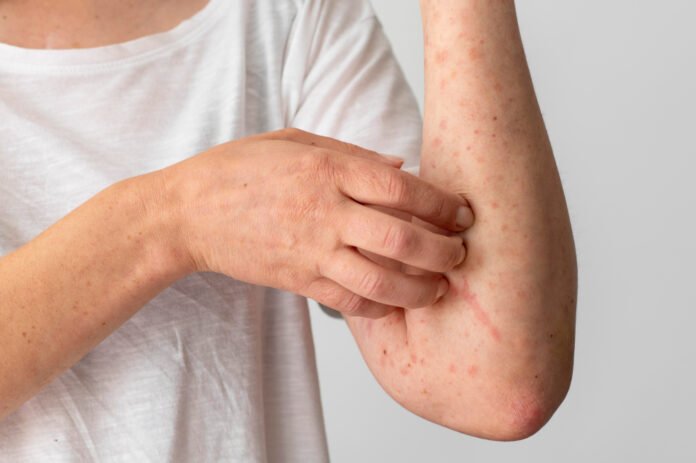Your skin, the body’s largest organ, serves as a primary defense against infection. However, sometimes bacteria can breach this barrier, leading to a variety of skin infections. These infections can range from mild, treatable at home, to severe conditions requiring immediate medical attention.
Bacterial skin infections are common and can affect anyone. They often appear as red, itchy spots or small, non-itchy red bumps. While many are caused by common bacteria like Staphylococcus aureus and can be treated with topical or oral antibiotics, some infections can become serious if they enter the bloodstream, a condition known as septicemia. Understanding the type of bacterial infection you may have is the first step toward effective treatment.
Common Types of Bacterial Skin Rashes and Infections
Bacterial skin infections manifest in various forms, each with distinct characteristics. Here are some of the most common types:
- Cellulitis: This infection affects the deeper layers of the skin, the dermis and subcutaneous tissue. The area often appears swollen and red and feels tender and warm to the touch. Bacteria typically enter through a break in the skin, such as a cut, burn, or ulcer. Because cellulitis can spread through the lymph nodes and bloodstream, seeking medical advice is crucial.
- Erysipelas: Often called “St. Anthony’s fire” due to the burning sensation it can cause, erysipelas affects the upper layers of the skin. It presents with redness and swelling and is similar to cellulitis, differing mainly in the depth of the infection. The bacteria responsible often enter through the nasal passages.
- Impetigo: A highly contagious superficial skin infection, impetigo is more common in children than adults. Caused by Streptococcus or Staphylococcus bacteria, it typically appears as sores around the nose and mouth that can spread through direct contact or by sharing towels and clothing. Treatment usually involves prescribed topical or oral antibiotics.
- Folliculitis: This common infection occurs when hair follicles become inflamed, often due to bacteria. It can also be caused by fungi, ingrown hairs, or blockages from skin products. Bacterial folliculitis often appears as small, red bumps or white-headed pimples. If left untreated, severe cases can lead to hair loss.
- Boils and Carbuncles: A boil is a painful, pus-filled lump that forms under the skin when bacteria infect a hair follicle. A carbuncle is a cluster of boils that are interconnected beneath the skin. They commonly occur on the back, thighs, and the back of the neck and can be accompanied by fever and fatigue. These are often caused by Stph bacteria and may require medical drainage to prevent scarring and further spread.
- Erythrasma: This infection, caused by Corynebacterium minutissimum, results in pink or red patches that can become brown and scaly. It typically occurs in skin folds, such as the armpits, groin, and between the toes. While often asymptomatic, it can cause mild itching or a burning sensation. Warm climates, excessive sweating, and conditions like diabetes are risk factors.
- Hot Tub Folliculitis: Also known as Pseudomonas folliculitis, this infection is caused by bacteria that thrive in warm, wet environments like hot tubs and swimming pools. It appears as an itchy, red rash with pus-filled bumps, often on the chest and groin area.
Bacteria Responsible for Skin Infections
Different types of bacteria cause specific skin conditions:
Staphylococcus aureus can cause:
Folliculitis
Abscesses
Impetigo
Boils (Furunculosis)
Streptococcus pyogenes can lead to:
Erysipelas
Cellulitis
Impetigo
Scarlet fever
Corynebacterium species are responsible for:
Erythrasma
Pitted keratolysis
Trichomycosis axillaris
When to See a Doctor
While some mild bacterial skin issues can be managed with over-the-counter treatments, it is essential to consult a healthcare professional for a proper diagnosis and treatment plan. If you notice a skin rash that is spreading rapidly, is painful, or is accompanied by fever, seek medical attention promptly. A dermatologist can identify the specific type of infection and prescribe the most effective topical or oral antibiotics to clear the infection and prevent complications.



